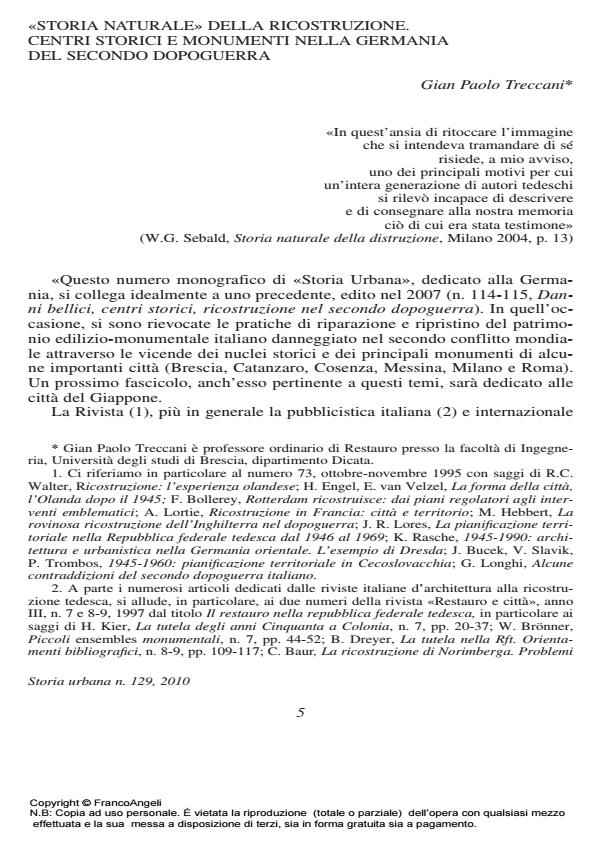«Storia naturale» della ricostruzione. Centri storici e monumenti nella Germania del secondo dopoguerra
Titolo Rivista STORIA URBANA
Autori/Curatori Gian Paolo Treccani
Anno di pubblicazione 2011 Fascicolo 2010/129
Lingua Italiano Numero pagine 18 P. 5-22 Dimensione file 687 KB
DOI 10.3280/SU2010-129001
Il DOI è il codice a barre della proprietà intellettuale: per saperne di più
clicca qui
Qui sotto puoi vedere in anteprima la prima pagina di questo articolo.
Se questo articolo ti interessa, lo puoi acquistare (e scaricare in formato pdf) seguendo le facili indicazioni per acquistare il download credit. Acquista Download Credits per scaricare questo Articolo in formato PDF

FrancoAngeli è membro della Publishers International Linking Association, Inc (PILA)associazione indipendente e non profit per facilitare (attraverso i servizi tecnologici implementati da CrossRef.org) l’accesso degli studiosi ai contenuti digitali nelle pubblicazioni professionali e scientifiche
Il saggio presenta i contenuti del volume di Storia Urbana dedicato alla ricostruzione in Germania dopo la seconda guerra mondiale; volume che si collega idealmente con quello edito nel 2007 sulla ricostruzione post bellica in Italia e un terzo, in corso di pubblicazione, dedicato alle città del Giappone. Le tre edizioni hanno l’obiettivo di cogliere i tratti comuni in queste esperienze nei territori sconfitti ma, anche, le peculiarità che caratterizzano ciascuna vicenda ricostruttiva nel decennio che segue la fine del conflitto. Il caso della Germania, analizzato in questo volume, si presenta particolarmente complesso e variegato già dalla questione dei danni. L’obiettivo dei bombardieri alleati fu di annientare psicologicamente, con la tecnica del moral bombing, la popolazione tedesca concentrata nei centri antichi degli agglomerati urbani che per questa ragione subirono danni di molto superiori a quelli, già ingentissimi, di paesi come l’Italia. Come emerge dai saggi contenuti nel volume, altre ragioni, quali i diversi modelli politici della parte est e ovest della Germania dopo la guerra, i fattori economici - favorevoli alla Germania Ovest con conseguenze però non sempre positive sui tessuti urbani danneggiati - l’ateismo di stato nell’Est, il differente significato attribuito ai valori identitari ma anche, infine, la continuità o meno con le politiche urbane pre-belliche se non addirittura pre naziste, prefigurarono, in ciascuna città, modalità di ricostruzione in molti casi profondamente differenti.
Parole chiave:Ricostruzione, danni, centro storico, monumento, Germania orientale, Germania occidentale
- The role of narratives in the preservation of post-war built legacies in Budapest Franz Bittenbinder, in TERRITORIO 101/2023 pp.7
DOI: 10.3280/TR2022-101001 - Building the Third Rome: Italy, the Vatican, and the new district in Prati di Castello, 1870–1895 Glauco Schettini, in Modern Italy /2019 pp.63
DOI: 10.1017/mit.2018.39
Gian Paolo Treccani, «Storia naturale» della ricostruzione. Centri storici e monumenti nella Germania del secondo dopoguerra in "STORIA URBANA " 129/2010, pp 5-22, DOI: 10.3280/SU2010-129001